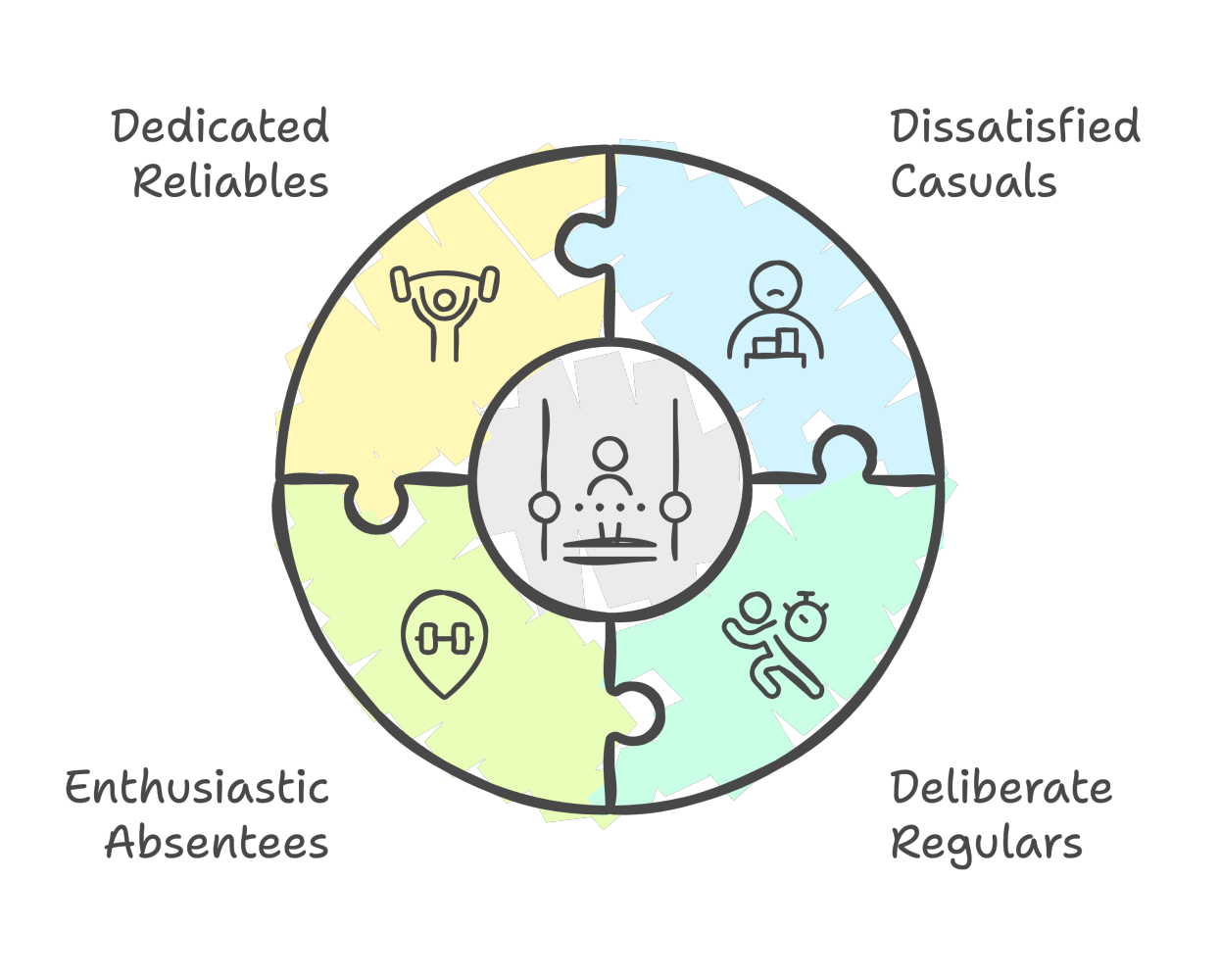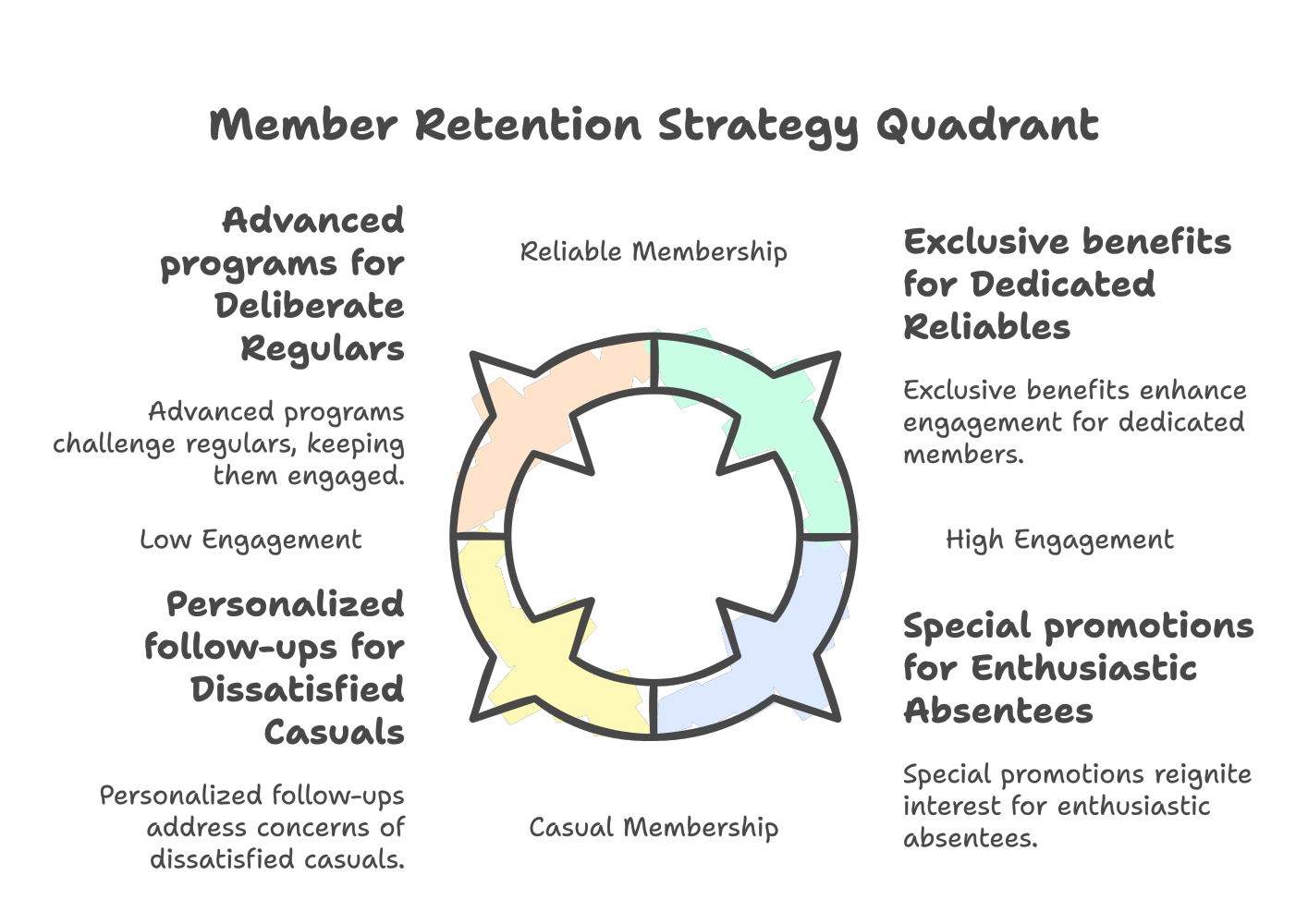Retention is a significant focus for gym owners. After all, bringing in new members is costly, but keeping existing ones is much more rewarding. However, improving retention isn’t a one-size-fits-all process. Every gym member is unique, with different motivations, behaviors, and needs. A recent study found that gym members fall into four distinct groups: Dissatisfied Casuals, Deliberate Regulars, Enthusiastic Absentees, and Dedicated Reliables. Understanding which group each member belongs to can unlock new opportunities to personalize engagement strategies and boost retention. In this article, we’ll explore how analyzing member behavior with these groups can lead to more effective, tailored retention strategies and why having access to this kind of data is essential for gym owners.
The Four Clusters of Gym Members
Research has revealed that not all gym members are equal regarding engagement and retention. By segmenting your members into four groups, you gain invaluable insights into their behavior and, most importantly, how to engage them effectively.

Dissatisfied Casuals: This group visits sporadically, and when they do, they’re often unhappy with their experience. They may feel disconnected from the gym and risk canceling their membership if their concerns aren’t addressed.
Deliberate Regulars: These members come to the gym on a routine basis. They are more committed but may still need encouragement to push their progress and avoid stagnation.
Enthusiastic Absentees: This group is the most promising but often the hardest to retain. They sign up eagerly but tend to disappear after a few visits. Engaging them requires a focus on reigniting their enthusiasm.
Dedicated Reliables: These members are your loyal customers, attending regularly and consistently. They are the backbone of your gym, and ensuring they remain satisfied is essential for long-term success.
Why is Group Analysis Critical?
Each group of members requires a tailored engagement strategy, but without data, gym owners often find it challenging to determine which approach will be most effective. The ability to categorize your members into these groups allows you to allocate resources more effectively and focus on the specific needs. For example, Dissatisfied Casuals may need more attention from trainers or improvements in the gym environment to feel more engaged and valued. On the other hand, Deliberate Regulars may benefit from programs designed to challenge them and prevent plateauing. At the same time, Enthusiastic Absentees may respond better to more frequent check-ins or reminders that reignite their initial excitement. With group data, you can target your engagement efforts with laser precision, leading to more effective retention strategies.
Tailored Retention Strategies for Each Group
Once you understand your members' behaviors, you can create retention strategies tailored to their specific needs.
For Dissatisfied Casuals
Engagement is key. Use personalized follow-ups to discover why they’re disengaged. Is it the equipment, the classes, or something else? Address their concerns, improve their experience, and offer incentives to come back.
Try personalized offers. Offer them an opportunity to meet with a trainer or try a new class to reignite their interest. Simple changes like a complimentary fitness assessment could make a difference.
For Deliberate Regulars
Keep them challenged. Regulars may benefit from more advanced programs or tracking systems highlighting their progress. Use data to show their improvements and set new goals to keep them engaged.
Create a Sense of Community. Encourage them to become mentors or part of small groups where they can motivate others. This fosters a sense of belonging and reinforces their commitment.
For Enthusiastic Absentees
Reignite the spark to their motivation. This group needs to be reminded of why they joined in the first place. Offering special promotions, time-sensitive challenges, or personalized re-engagement emails can help spark their interest again.
Accountability structures. Create systems that hold them accountable, like personal check-ins or automated reminders, to help them return to the gym with renewed focus.
For Dedicated Reliables
Keep them engaged and rewarded. These members are already loyal, so ensure they feel valued. Offer exclusive benefits, such as members-only classes or social events, to make them feel like VIPs.
Keep track of their progress. These members are likely focused on their fitness goals, so help them track their progress and keep them motivated with regular assessments and performance feedback.
The Role of Analytics in Enhancing Retention
In the past, gym owners had to rely on intuition or broad generalizations to manage retention. Today, access to detailed group analytics transforms this process.
How Does Analytics Make a Difference?
With the correct data, you can identify which members belong to which group. From there, you can personalize outreach, tailor programs to fit their needs and track progress over time to determine the most effective engagement strategies. For example, if your gym uses analytics to identify Enthusiastic Absentees, you can send targeted re-engagement emails offering specific classes or discounts that cater to their interests. If you notice that Dissatisfied Casuals tend to leave after certain classes or experiences, you can make adjustments to improve satisfaction and prevent churn. Analytics help you understand why members leave, not just when they leave, providing the insights you need to keep them longer.Why Your Gym Needs Access to This Data
Data-driven retention strategies aren’t just a nice-to-have—they’re necessary for modern gyms. With analytics, you can streamline your engagement efforts, reduce wasted marketing spend, and, most importantly, improve your bottom line. By investing in software that helps you analyze member behavior and categorize them into meaningful groups, you get more than just numbers—you gain insights into how to keep your gym members engaged. This empowers you to deliver a personalized experience that members value, fostering loyalty and improving retention rates across the board.Conclusion
Retention starts with understanding your members. You can tailor your engagement strategies to meet their unique needs by segmenting them into different groups based on their behavior. Gym owners with access to this kind of group analysis have a clear advantage. Not only can they reduce churn rates, but they can also create deeper, more meaningful connections with their members. When you understand what motivates each member, you can transform their experience at your gym—leading to higher retention rates, more referrals, and ultimately, greater success for your business. With the right tools, the future of gym retention is data-driven and tailored to fit every member.
